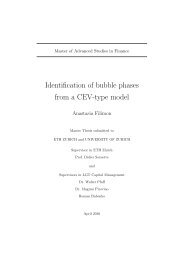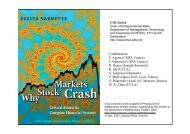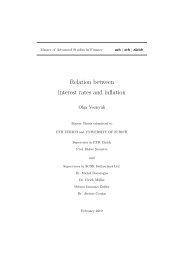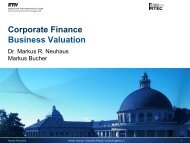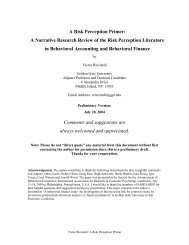Tail Dependence - ETH - Entrepreneurial Risks - ETH Zürich
Tail Dependence - ETH - Entrepreneurial Risks - ETH Zürich
Tail Dependence - ETH - Entrepreneurial Risks - ETH Zürich
Create successful ePaper yourself
Turn your PDF publications into a flip-book with our unique Google optimized e-Paper software.
3.6 Establishing the uncertainty of estimated upper and lower tail indexes<br />
ˆν by creating bs = 1000 bootstrap samples of historical return data for<br />
S&P 500 and included assets and calculation of bootstrap mean value<br />
νmean with rel. error from the original value, deviation quantiles and<br />
standard deviation from νmean, and most extreme deviation value. The<br />
tail represents the most extreme 4 % of the return values during a time<br />
interval ranging from January 1991 to December 2000 (k = 100 values)<br />
and from July 1985 to April 2008 (k = 229 values). . . . . . . . . . . . 29<br />
3.7 Establishing the uncertainty of estimated upper and lower tail indexes ˆ b γ n<br />
by creating bootstrap samples (bs) of historical return data for S&P 500<br />
and included assets and calculation of bootstrap mean value νmean with<br />
rel. error from the original value, deviation quantiles and standard deviation<br />
from bγ mean , and most extreme deviation value. The tail represents<br />
the most extreme 4 % of the return values during a time interval ranging<br />
from January 1991 to December 2000 (k = 100 values, bs = 1000) and<br />
from July 1985 to April 2008 (k = 229 values, bs = 650). . . . . . . . . 30<br />
3.8 Estimated values of upper and lower tail dependence for S&P 500 index<br />
with a set of nine major assets traded on the New York stock Exchange<br />
calculated by a non-parametric approach: ˆ λ +,− �<br />
= 1/ max 1, l<br />
�ν on β<br />
the left and by a parametric approach: ˆ λ +,− �<br />
= 1/ 1 + β−ν · Cε<br />
�<br />
on CY<br />
the right. The tail represents the most extreme 4% of the return values<br />
during a time interval from January 1991 to December 2000. ’tail’ shows<br />
the calculation interval of l with c = 13 and k = 100 and ∗ denotes<br />
negative ˆ β. . . . . . . . . . . . . . . . . . . . . . . . . . . . . . . . . . . 34<br />
3.9 Estimated values of upper and lower tail dependence for S&P 500 index<br />
with a set of nine major assets traded on the New York stock Exchange<br />
calculated by a non-parametric approach: ˆ λ +,− �<br />
= 1/ max 1, l<br />
� γ<br />
bn on β<br />
the left and by a parametric approach: ˆ λ +,− �<br />
= 1/ 1 + β−bγ �<br />
n Cε · on CY<br />
the right. The tail represents the most extreme 4% of the return values<br />
during a time interval from January 1991 to December 2000. ’tail’ shows<br />
the calculation interval of l with c = 13 and k = 100 and ∗ denotes<br />
negative ˆ β. . . . . . . . . . . . . . . . . . . . . . . . . . . . . . . . . . .<br />
3.10 Estimated values of upper and lower tail dependence for S&P 500 index<br />
with a set of nine major assets traded on the New York stock Exchange<br />
calculated by a non-parametric approach:<br />
35<br />
ˆ λ +,− �<br />
= 1/ max 1, l<br />
�ν on β<br />
the left and by a parametric approach: ˆ λ +,− �<br />
= 1/ 1 + β−ν · Cε<br />
�<br />
on CY<br />
the right. The tail represents the most extreme 4% of the return values<br />
during a time interval from July 1985 to April 2008. ’tail’ shows the<br />
calculation interval of l with c = 29 and k = 229. . . . . . . . . . . . . 35



